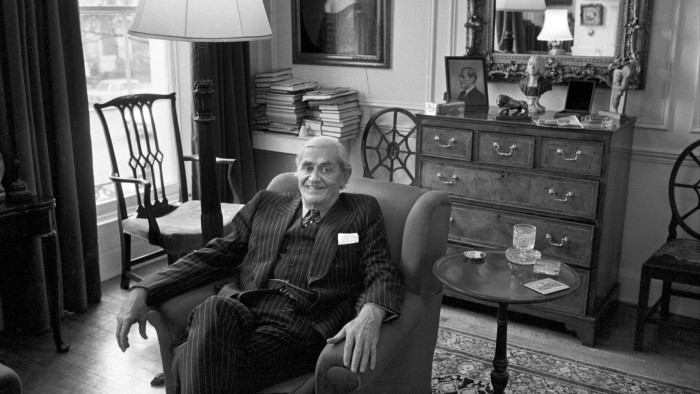Unlock the Editor’s Digest for free
Roula Khalaf, Editor of the FT, selects her favourite stories in this weekly newsletter.
The fact that this gripping exposé of a troubling and troubled man omits Dr William Sargant’s name from its title tells us how far one of London’s best-connected psychiatrists — Robert Graves, his one-time ghostwriter, was a close friend — has fallen since the days when appreciative private patients thanked him with gifts of Rolls-Royces.
Born in 1907, Sargant first earned his reputation as a medical wunderkind in the 1940s, when he started treating soldiers suffering from PTSD with an eye-wateringly high combination of narcotics and electric shocks. But fame never won him a coveted knighthood or emeritus professorship; no blue plaque marks Sargant’s Regency home. After reading Jon Stock’s damning account, few readers will wonder why.
The Sleep Room marks the author’s first venture away from writing psychological thrillers. That world never feels far away. Here, narrative sections are interspersed with the voices of former patients who describe just how terrifying it felt to be placed by well-meaning parents under Sargant’s unfettered power for up to three months, at a notoriously carefree time (the 1960s and early 1970s) when no medical consents were required.
Young women became Sargant’s speciality. The actress Celia Imrie was just 14 and suffering from anorexia when she began her three-month stint in “the Sleep Room”, tucked away on a low-ceilinged attic floor of the Royal Waterloo Hospital. Today, Imrie recalls Sargant as “a truly horrifying man”. Linda Keith (the model and muse for Keith Richards’ haunting “Ruby Tuesday”) lost the ability to read, or even to identify her parents after receiving 50 hyper-charged treatments of electroshock bolts, delivered to her drugged body by Sargant’s portable, personally purchased machine. “It was,” she told Stock, “as if my brain and personality were dead.” Had Sargant ever read Mary Shelley’s Frankenstein? Stock doesn’t say.
Sargant was converted to the merits of lobotomy by a 1938 encounter in the US with Walter Freeman (who subsequently performed that procedure, with tragic results, on Rosemary Kennedy, sister of JFK), and his breakthrough in the world of mind-control came with his appointment in 1939 to Belmont, an extension of the Maudsley psychiatric hospital in south-east London. Once there, he was given a free hand to experiment on disoriented ex-servicemen. Sargant, in Stock’s words, “couldn’t believe his luck”.
At Belmont, the foundations were laid for Sargant’s future career. Using his war-damaged patients as guinea pigs, he found that a powerful sedative like the barbiturate sodium amytal could prepare a distressed nervous system for regular and massive jolts of electric shock treatment, far above any normal levels, delivered while the sufferer slept.
Scary stuff. It gets worse. At Belmont, concerned members of the London County Council failed to get Sargant outlawed from conducting lobotomies. At nearby St Thomas’ Hospital, the directors thought well enough of Sargant’s achievements to offer him, in 1948, the founding year of the NHS, a permanent appointment as their in-house head of psychological medicine.
Starting in a rat-infested basement nicknamed “Scutari” (Stock fails to point out that Florence Nightingale’s first London hospital, now a museum, once occupied that same site), Sargant swiftly removed his “Sleep Room” operation to the remote top floor of a nearby sister hospital: the Royal Waterloo. Here, locked away from public view, Sargant’s victimised young patients lay supine, physically humiliated, seldom conscious and regularly electroconvulsed for months on end. A handful of survivors believe they were subjected to sexual abuse, that rapes were conducted during their chemically extended slumbers.
Sargant tried to destroy his case records before leaving the NHS in 1972 to work with mentally troubled private patients at the celebrated Priory Hospital in Roehampton. Ugly rumours spread about just what had gone on in the secretive “Sleep Room”. No formal investigations were ever made. As with so much of Sargant’s headstrong and dangerous career, the truth remains impossible to establish, but if John Banville, master of the creepily unsavoury in fiction, is looking for new inspiration, Jon Stock just may have supplied it in these chilling pages.
The Sleep Room: A Very British Medical Scandal by Jon Stock The Bridge Street Press £25, 432 pages
Join our online book group on Facebook at FT Books Café and follow FT Weekend on Instagram and X
Read the full article here

